Reforms in Agriculture Industries in Australia
VerifiedAdded on 2023/06/15
|9
|1617
|238
AI Summary
This report discusses the reforms in agriculture industries in Australia over the decades. It highlights the role of Australian government in bringing about reforms in the agricultural sector. The economic analysis presenting the issue is also discussed in this report.
Contribute Materials
Your contribution can guide someone’s learning journey. Share your
documents today.
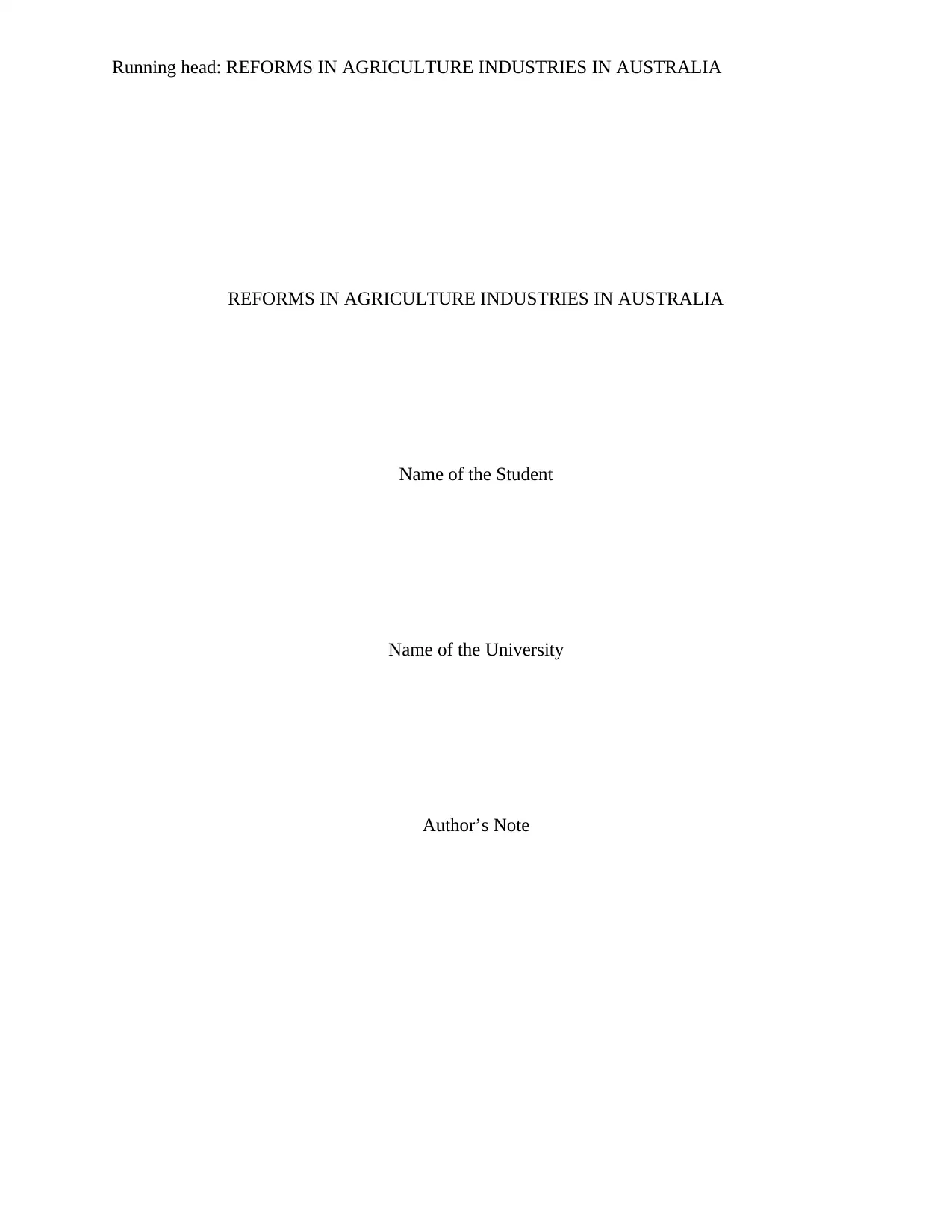
Running head: REFORMS IN AGRICULTURE INDUSTRIES IN AUSTRALIA
REFORMS IN AGRICULTURE INDUSTRIES IN AUSTRALIA
Name of the Student
Name of the University
Author’s Note
REFORMS IN AGRICULTURE INDUSTRIES IN AUSTRALIA
Name of the Student
Name of the University
Author’s Note
Secure Best Marks with AI Grader
Need help grading? Try our AI Grader for instant feedback on your assignments.
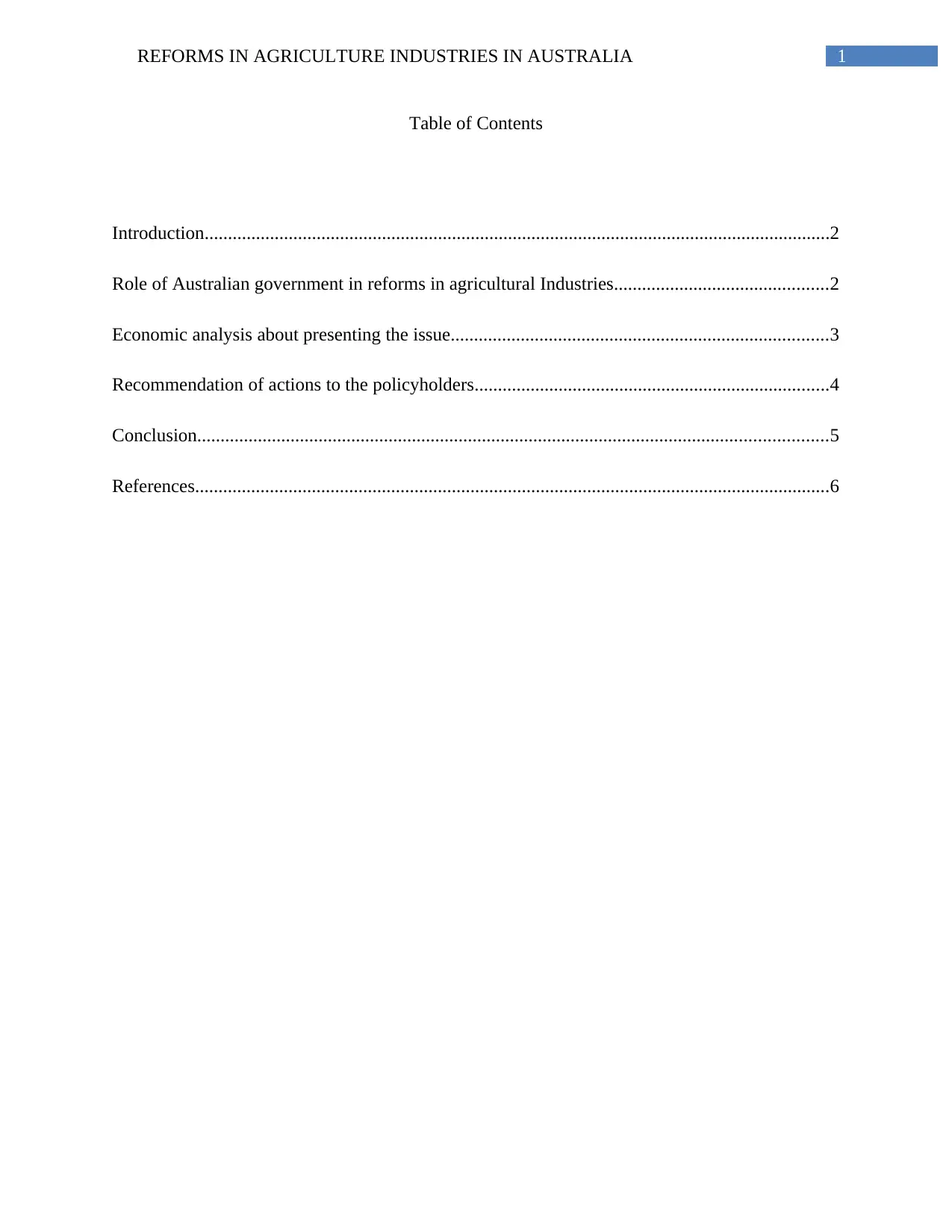
1REFORMS IN AGRICULTURE INDUSTRIES IN AUSTRALIA
Table of Contents
Introduction......................................................................................................................................2
Role of Australian government in reforms in agricultural Industries..............................................2
Economic analysis about presenting the issue.................................................................................3
Recommendation of actions to the policyholders............................................................................4
Conclusion.......................................................................................................................................5
References........................................................................................................................................6
Table of Contents
Introduction......................................................................................................................................2
Role of Australian government in reforms in agricultural Industries..............................................2
Economic analysis about presenting the issue.................................................................................3
Recommendation of actions to the policyholders............................................................................4
Conclusion.......................................................................................................................................5
References........................................................................................................................................6
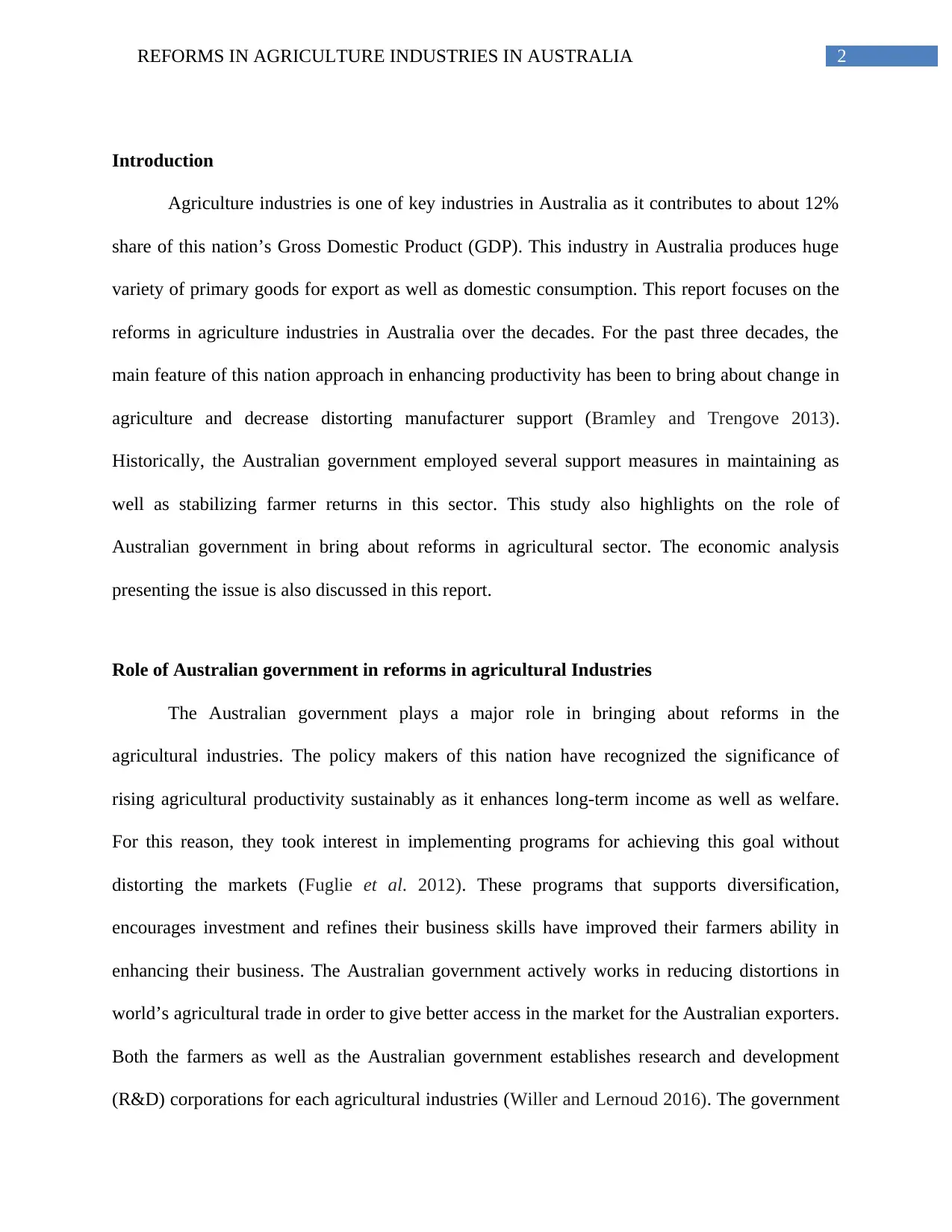
2REFORMS IN AGRICULTURE INDUSTRIES IN AUSTRALIA
Introduction
Agriculture industries is one of key industries in Australia as it contributes to about 12%
share of this nation’s Gross Domestic Product (GDP). This industry in Australia produces huge
variety of primary goods for export as well as domestic consumption. This report focuses on the
reforms in agriculture industries in Australia over the decades. For the past three decades, the
main feature of this nation approach in enhancing productivity has been to bring about change in
agriculture and decrease distorting manufacturer support (Bramley and Trengove 2013).
Historically, the Australian government employed several support measures in maintaining as
well as stabilizing farmer returns in this sector. This study also highlights on the role of
Australian government in bring about reforms in agricultural sector. The economic analysis
presenting the issue is also discussed in this report.
Role of Australian government in reforms in agricultural Industries
The Australian government plays a major role in bringing about reforms in the
agricultural industries. The policy makers of this nation have recognized the significance of
rising agricultural productivity sustainably as it enhances long-term income as well as welfare.
For this reason, they took interest in implementing programs for achieving this goal without
distorting the markets (Fuglie et al. 2012). These programs that supports diversification,
encourages investment and refines their business skills have improved their farmers ability in
enhancing their business. The Australian government actively works in reducing distortions in
world’s agricultural trade in order to give better access in the market for the Australian exporters.
Both the farmers as well as the Australian government establishes research and development
(R&D) corporations for each agricultural industries (Willer and Lernoud 2016). The government
Introduction
Agriculture industries is one of key industries in Australia as it contributes to about 12%
share of this nation’s Gross Domestic Product (GDP). This industry in Australia produces huge
variety of primary goods for export as well as domestic consumption. This report focuses on the
reforms in agriculture industries in Australia over the decades. For the past three decades, the
main feature of this nation approach in enhancing productivity has been to bring about change in
agriculture and decrease distorting manufacturer support (Bramley and Trengove 2013).
Historically, the Australian government employed several support measures in maintaining as
well as stabilizing farmer returns in this sector. This study also highlights on the role of
Australian government in bring about reforms in agricultural sector. The economic analysis
presenting the issue is also discussed in this report.
Role of Australian government in reforms in agricultural Industries
The Australian government plays a major role in bringing about reforms in the
agricultural industries. The policy makers of this nation have recognized the significance of
rising agricultural productivity sustainably as it enhances long-term income as well as welfare.
For this reason, they took interest in implementing programs for achieving this goal without
distorting the markets (Fuglie et al. 2012). These programs that supports diversification,
encourages investment and refines their business skills have improved their farmers ability in
enhancing their business. The Australian government actively works in reducing distortions in
world’s agricultural trade in order to give better access in the market for the Australian exporters.
Both the farmers as well as the Australian government establishes research and development
(R&D) corporations for each agricultural industries (Willer and Lernoud 2016). The government

3REFORMS IN AGRICULTURE INDUSTRIES IN AUSTRALIA
contribution to R&D bodies helps them in researching about new farming methods, which in turn
improves productivity and adaptation to change in climate. The Australian government is mainly
interested in bringing change in agricultural industry as this sector plays bigger role in exporting
products and services and contributes in national income and employment.
Economic analysis about presenting the issue
Reforms of agricultural policies in Australia started in 1970, when the government sought
in limiting the financial assistance given through the budgetary measures. Early reforms
introduced stabilized prices in agricultural goods and placed larger emphasis on providing
assistance. Subsequent change aimed in making decision-making highly responsive to the market
forces and decreased the level of assistance within the industry. The reforms in Australia’s
agricultural sector include reduction in tariff, wider protection measures and removal of subsidy
in fertilizer consumption.
Tariff refers to tax on exports or imports of goods between the sovereign states. The
government imposes tariff for restricting trade as it increases the prices of imported products,
making them highly expensive to the consumers. Therefore, reduction in tariff led to growth of
agricultural goods that are to be traded. Hence, it also led to creation of trade in this nation.
Subsidy is termed as the benefits that the government offers to the individuals or industries in
different forms including welfare payment, allowance of tax keeping low prices of products etc.
Removal of subsidy in fertilizer consumption helped the Australian government in saving huge
amount of money (Rickards and Howden 2012). In addition, the Australian government also
imposed education programs to the farmers including marketing, strategic planning, production
management and resource management. As a result, it improved the business skills of the
contribution to R&D bodies helps them in researching about new farming methods, which in turn
improves productivity and adaptation to change in climate. The Australian government is mainly
interested in bringing change in agricultural industry as this sector plays bigger role in exporting
products and services and contributes in national income and employment.
Economic analysis about presenting the issue
Reforms of agricultural policies in Australia started in 1970, when the government sought
in limiting the financial assistance given through the budgetary measures. Early reforms
introduced stabilized prices in agricultural goods and placed larger emphasis on providing
assistance. Subsequent change aimed in making decision-making highly responsive to the market
forces and decreased the level of assistance within the industry. The reforms in Australia’s
agricultural sector include reduction in tariff, wider protection measures and removal of subsidy
in fertilizer consumption.
Tariff refers to tax on exports or imports of goods between the sovereign states. The
government imposes tariff for restricting trade as it increases the prices of imported products,
making them highly expensive to the consumers. Therefore, reduction in tariff led to growth of
agricultural goods that are to be traded. Hence, it also led to creation of trade in this nation.
Subsidy is termed as the benefits that the government offers to the individuals or industries in
different forms including welfare payment, allowance of tax keeping low prices of products etc.
Removal of subsidy in fertilizer consumption helped the Australian government in saving huge
amount of money (Rickards and Howden 2012). In addition, the Australian government also
imposed education programs to the farmers including marketing, strategic planning, production
management and resource management. As a result, it improved the business skills of the
Secure Best Marks with AI Grader
Need help grading? Try our AI Grader for instant feedback on your assignments.
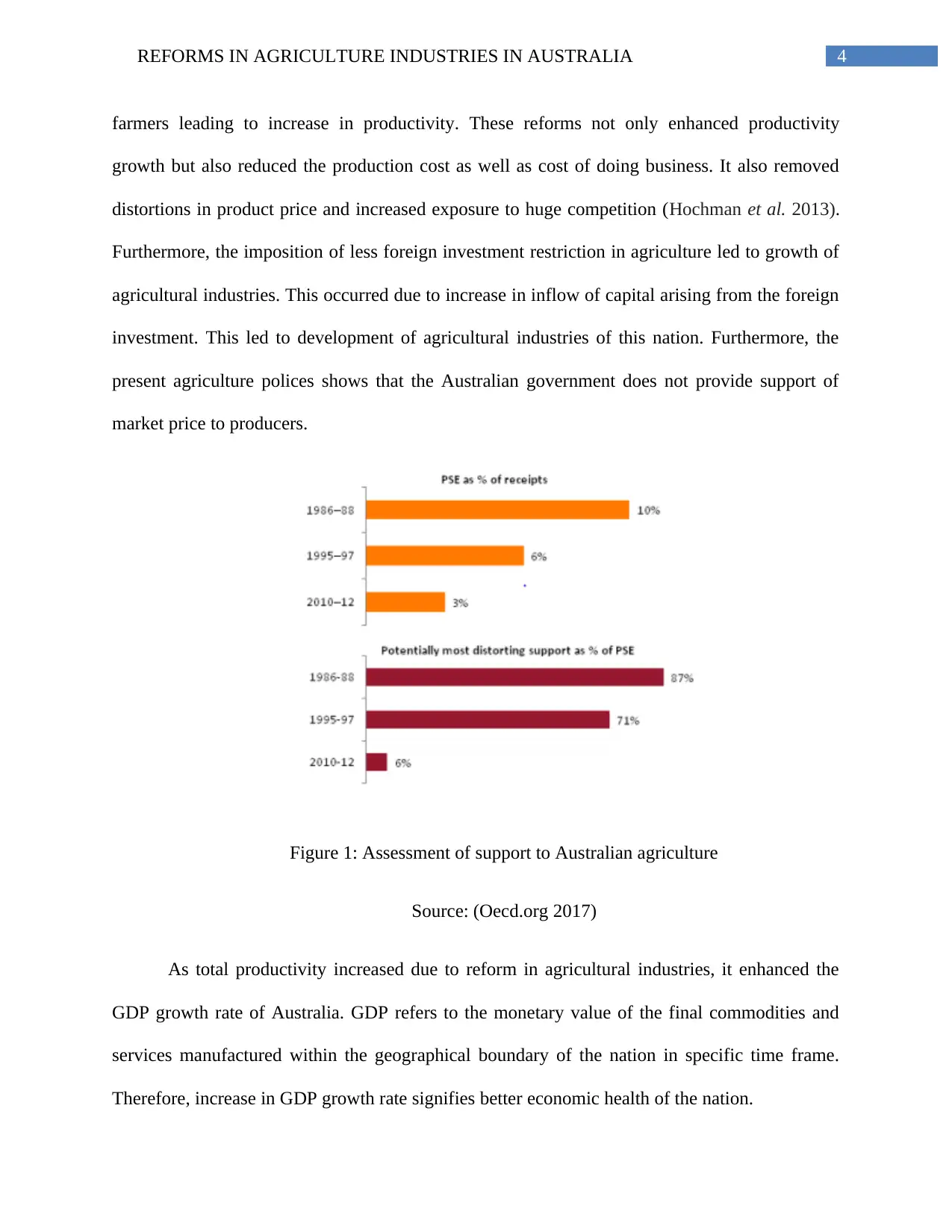
4REFORMS IN AGRICULTURE INDUSTRIES IN AUSTRALIA
farmers leading to increase in productivity. These reforms not only enhanced productivity
growth but also reduced the production cost as well as cost of doing business. It also removed
distortions in product price and increased exposure to huge competition (Hochman et al. 2013).
Furthermore, the imposition of less foreign investment restriction in agriculture led to growth of
agricultural industries. This occurred due to increase in inflow of capital arising from the foreign
investment. This led to development of agricultural industries of this nation. Furthermore, the
present agriculture polices shows that the Australian government does not provide support of
market price to producers.
Figure 1: Assessment of support to Australian agriculture
Source: (Oecd.org 2017)
As total productivity increased due to reform in agricultural industries, it enhanced the
GDP growth rate of Australia. GDP refers to the monetary value of the final commodities and
services manufactured within the geographical boundary of the nation in specific time frame.
Therefore, increase in GDP growth rate signifies better economic health of the nation.
farmers leading to increase in productivity. These reforms not only enhanced productivity
growth but also reduced the production cost as well as cost of doing business. It also removed
distortions in product price and increased exposure to huge competition (Hochman et al. 2013).
Furthermore, the imposition of less foreign investment restriction in agriculture led to growth of
agricultural industries. This occurred due to increase in inflow of capital arising from the foreign
investment. This led to development of agricultural industries of this nation. Furthermore, the
present agriculture polices shows that the Australian government does not provide support of
market price to producers.
Figure 1: Assessment of support to Australian agriculture
Source: (Oecd.org 2017)
As total productivity increased due to reform in agricultural industries, it enhanced the
GDP growth rate of Australia. GDP refers to the monetary value of the final commodities and
services manufactured within the geographical boundary of the nation in specific time frame.
Therefore, increase in GDP growth rate signifies better economic health of the nation.

5REFORMS IN AGRICULTURE INDUSTRIES IN AUSTRALIA
Figure 1: The GDP of Australia from Agriculture
Source: (tradingeconomics.com 2017)
Recommendation of actions to the policyholders
As the Australian government plays vital role in changing their agricultural industries, certain
recommendation on the actions to be taken by the policymakers is given below:
The Australian government should take effectual account on the requirements as well as
decision-making procedure of the farmers and must also ensure flexibility in adaption
programs in order to satisfy their farmers (Sheng et al. 2015).
It is suggested that the key holders should adapt more research techniques for mitigating
greenhouse gas emission from this agricultural sector.
The policymakers in response to problems impacting agriculture should increase their
investment as well as support for adapting further research methods into efficiency in
energy in this industry especially, biofuels, biochar etc.
Figure 1: The GDP of Australia from Agriculture
Source: (tradingeconomics.com 2017)
Recommendation of actions to the policyholders
As the Australian government plays vital role in changing their agricultural industries, certain
recommendation on the actions to be taken by the policymakers is given below:
The Australian government should take effectual account on the requirements as well as
decision-making procedure of the farmers and must also ensure flexibility in adaption
programs in order to satisfy their farmers (Sheng et al. 2015).
It is suggested that the key holders should adapt more research techniques for mitigating
greenhouse gas emission from this agricultural sector.
The policymakers in response to problems impacting agriculture should increase their
investment as well as support for adapting further research methods into efficiency in
energy in this industry especially, biofuels, biochar etc.
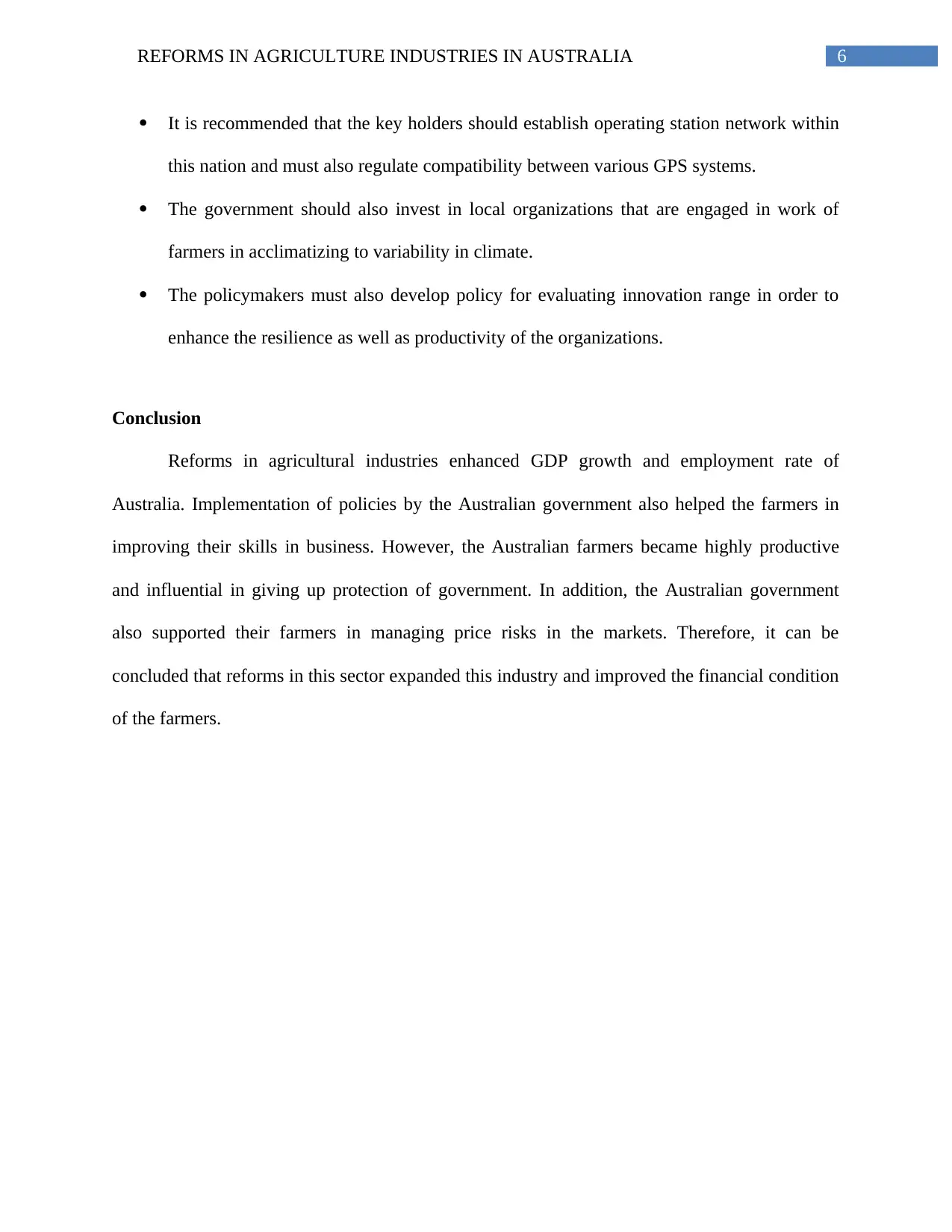
6REFORMS IN AGRICULTURE INDUSTRIES IN AUSTRALIA
It is recommended that the key holders should establish operating station network within
this nation and must also regulate compatibility between various GPS systems.
The government should also invest in local organizations that are engaged in work of
farmers in acclimatizing to variability in climate.
The policymakers must also develop policy for evaluating innovation range in order to
enhance the resilience as well as productivity of the organizations.
Conclusion
Reforms in agricultural industries enhanced GDP growth and employment rate of
Australia. Implementation of policies by the Australian government also helped the farmers in
improving their skills in business. However, the Australian farmers became highly productive
and influential in giving up protection of government. In addition, the Australian government
also supported their farmers in managing price risks in the markets. Therefore, it can be
concluded that reforms in this sector expanded this industry and improved the financial condition
of the farmers.
It is recommended that the key holders should establish operating station network within
this nation and must also regulate compatibility between various GPS systems.
The government should also invest in local organizations that are engaged in work of
farmers in acclimatizing to variability in climate.
The policymakers must also develop policy for evaluating innovation range in order to
enhance the resilience as well as productivity of the organizations.
Conclusion
Reforms in agricultural industries enhanced GDP growth and employment rate of
Australia. Implementation of policies by the Australian government also helped the farmers in
improving their skills in business. However, the Australian farmers became highly productive
and influential in giving up protection of government. In addition, the Australian government
also supported their farmers in managing price risks in the markets. Therefore, it can be
concluded that reforms in this sector expanded this industry and improved the financial condition
of the farmers.
Paraphrase This Document
Need a fresh take? Get an instant paraphrase of this document with our AI Paraphraser

7REFORMS IN AGRICULTURE INDUSTRIES IN AUSTRALIA
References
Bramley, R. and Trengove, S., 2013. Precision agriculture in Australia: present status and recent
developments. Engenharia Agrícola, 33(3), pp.575-588.
Fuglie, K.O., Wang, S.L. and Ball, V.E. eds., 2012. Productivity growth in agriculture: an
international perspective. CABI.
Hochman, Z., Carberry, P.S., Robertson, M.J., Gaydon, D.S., Bell, L.W. and McIntosh, P.C.,
2013. Prospects for ecological intensification of Australian agriculture. European Journal of
Agronomy, 44, pp.109-123.
Lawrence, G., Richards, C. and Lyons, K., 2013. Food security in Australia in an era of
neoliberalism, productivism and climate change. Journal of Rural Studies, 29, pp.30-39.
Oecd.org. (2017). Cite a Website - Cite This For Me. [online] Available at:
https://www.oecd.org/tad/events/Mr.%20Merrilees_Agricultural%20productivity%20growth
%20reforms%20opportunities.pdf [Accessed 30 Nov. 2017].
Puri, M., Abraham, R.E. and Barrow, C.J., 2012. Biofuel production: prospects, challenges and
feedstock in Australia. Renewable and Sustainable Energy Reviews, 16(8), pp.6022-6031.
Rickards, L. and Howden, S.M., 2012. Transformational adaptation: agriculture and climate
change. Crop and Pasture Science, 63(3), pp.240-250.
Sheng, Y., Zhao, S., Nossal, K. and Zhang, D., 2015. Productivity and farm size in Australian
agriculture: reinvestigating the returns to scale. Australian Journal of Agricultural and Resource
Economics, 59(1), pp.16-38.
References
Bramley, R. and Trengove, S., 2013. Precision agriculture in Australia: present status and recent
developments. Engenharia Agrícola, 33(3), pp.575-588.
Fuglie, K.O., Wang, S.L. and Ball, V.E. eds., 2012. Productivity growth in agriculture: an
international perspective. CABI.
Hochman, Z., Carberry, P.S., Robertson, M.J., Gaydon, D.S., Bell, L.W. and McIntosh, P.C.,
2013. Prospects for ecological intensification of Australian agriculture. European Journal of
Agronomy, 44, pp.109-123.
Lawrence, G., Richards, C. and Lyons, K., 2013. Food security in Australia in an era of
neoliberalism, productivism and climate change. Journal of Rural Studies, 29, pp.30-39.
Oecd.org. (2017). Cite a Website - Cite This For Me. [online] Available at:
https://www.oecd.org/tad/events/Mr.%20Merrilees_Agricultural%20productivity%20growth
%20reforms%20opportunities.pdf [Accessed 30 Nov. 2017].
Puri, M., Abraham, R.E. and Barrow, C.J., 2012. Biofuel production: prospects, challenges and
feedstock in Australia. Renewable and Sustainable Energy Reviews, 16(8), pp.6022-6031.
Rickards, L. and Howden, S.M., 2012. Transformational adaptation: agriculture and climate
change. Crop and Pasture Science, 63(3), pp.240-250.
Sheng, Y., Zhao, S., Nossal, K. and Zhang, D., 2015. Productivity and farm size in Australian
agriculture: reinvestigating the returns to scale. Australian Journal of Agricultural and Resource
Economics, 59(1), pp.16-38.

8REFORMS IN AGRICULTURE INDUSTRIES IN AUSTRALIA
Tradingeconomics.com. (2017). Australia GDP From Agriculture | 1974-2017 | Data | Chart |
Calendar. [online] Available at: https://tradingeconomics.com/australia/gdp-from-agriculture
[Accessed 30 Nov. 2017].
Willer, H. and Lernoud, J., 2016. The world of organic agriculture. Statistics and emerging
trends 2016 (pp. 1-336). Research Institute of Organic Agriculture FiBL and IFOAM Organics
International.
Tradingeconomics.com. (2017). Australia GDP From Agriculture | 1974-2017 | Data | Chart |
Calendar. [online] Available at: https://tradingeconomics.com/australia/gdp-from-agriculture
[Accessed 30 Nov. 2017].
Willer, H. and Lernoud, J., 2016. The world of organic agriculture. Statistics and emerging
trends 2016 (pp. 1-336). Research Institute of Organic Agriculture FiBL and IFOAM Organics
International.
1 out of 9
Related Documents
Your All-in-One AI-Powered Toolkit for Academic Success.
+13062052269
info@desklib.com
Available 24*7 on WhatsApp / Email
![[object Object]](/_next/static/media/star-bottom.7253800d.svg)
Unlock your academic potential
© 2024 | Zucol Services PVT LTD | All rights reserved.





